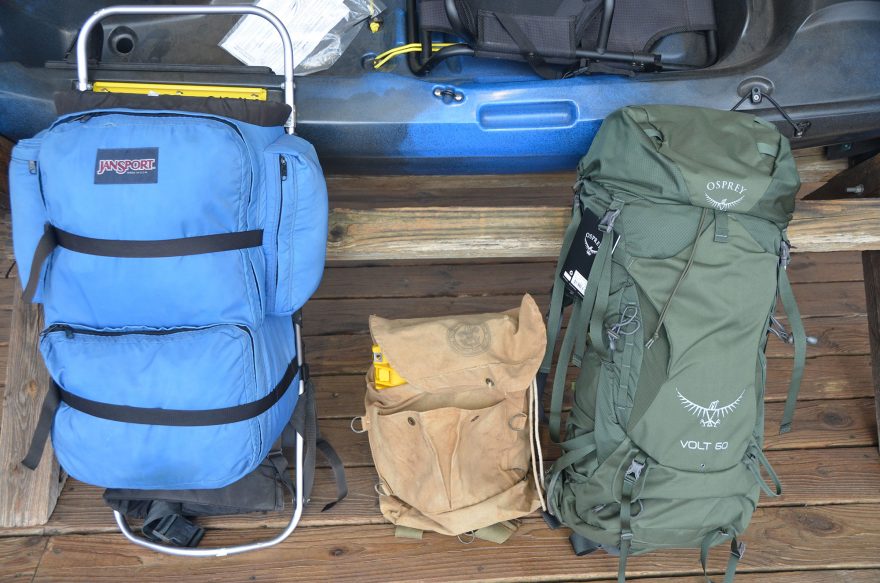
My first backpack was purchased by my parents (I imagine by Mom at Fields Department Store in Jackson, Michigan) in 1949 or 1950, in preparation for my first trip to Wolf Lake Boy Scout Camp. I still have it, but it’s not up to my current needs. And while there are a wealth of day packs, fanny packs and shoulder packs available, here let’s consider packs suitable for a multi-day trip into the backcountry.
Two types of pack dominate: external and internal models. The external/internal reference related to the frame, which holds the pack in shape. Whichever modal you chose, make sure it fits. Among the beauties of life, we are not all made the same.
Consider the suspension system of the pack you consider. How do the shoulder straps adjust? How about the hip belt? A good back pack is going to set you back some cash, possibly even a couple of hundred dollars. Go to a reliable outfitter and get help. Put the back pack on. Load it up (many places have sand bags or other weights to simulate the experience of a loaded pack). Walk around the shop.
An external frame pack has an aluminum or plastic lattice work about three feet high and a couple of feet wide. The frame suspends the load away from the hiker’s back and permits air to circulate between the pack and the hiker. Further, the frame shifts the weight of the load to a padded belt and onto the lower back of the hiker, where it is most comfortably carried. The principle function of the shoulder straps is to prevent the load from tipping backwards. There is sometimes a top-heavy feeling with external frame packs.
Some of the most popular ones are:

Internal frame packs (which are certainly the most common these days) are stabilized by aluminum stays inside the pack, often assisted by a polyethylene layer to provide stability. The advantage of an internal frame pack is it flexes with the hiker and avoids the top-heavy feeling associated with external frame packs. Unlike the external frame back, however, the load rests on the hiker’s back and no air circulates between the back and the hiker. On a long hike on a warm day, expect to get sweaty.
A handful that have stood out recently include:
- Osprey Atmos AG 50
- Deuter Aircontact Lite
- Gregory Baltoro 65
- Mountain Hardwear Direttissima 35
- Black Diamond Speed 30
Rudy Hayden, Manager at Great Outdoor Provision Company in Charlotte, North Carolina, said, “We no longer carry the external frame packs. There’s no market for them. The advantage of the external frame pack is the air flow around it. The internal frame packs are more comfortable and provide better balance for hiking.”
Both models usually accommodate lashing gear to the top and bottom. Consider how this will modify the weight distribution of your load. Generally speaking, I prefer to lash heavy items lower, shifting weight to the hips. There should be D rings on the pack and perhaps some web straps, which allow lashing gear to the top, bottom and perhaps the sides (I don’t like gear on the sides, but it’s an option). A prime candidate for lashing on a pack is a tent.
I like several side or back pouches for easy access to gear, perhaps a camera or a other small item subject to frequent use. Backpackers need water and many packs have a slot inside the pack for a water bladder with an external access permitting a hiker to pull a tube forward to get a drink. I like this feature so much I have had several packs that did not have this feature modified to include it. If your neighborhood does not have a seamstress willing to make such modifications, move.
Tim Mead is an outdoor writer with 35 years experience. His articles and photos have appeared in national, regional and state magazines. He is Past President of the Southeastern Outdoor Press Association and current President of the Outdoor Writers Association of America.
The feature photo by Tim Mead shows his external frame pack on the left, Boy Scout pack in the center and internal frame pack on the right. Secondary image by Dudarev Mikhail, Shutterstock
We are committed to finding, researching, and recommending the best products. We earn commissions from purchases you make using the retail links in our product reviews. Learn more about how this works.

 Your Privacy Choices
Your Privacy Choices

